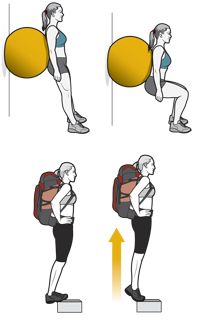Products You May Like
We love all trips, from short to long ones. But some of the greatest adventures out there are lengthy treks, and to tackle them, you’ll need both the physical strength to schlep a pack for that long and the know-how to prep your gear and find your route. We’ve collected a crash course from our experts’ best tips. —The Edtiors
Strength Training
You don’t need to be a bodybuilder for backpacking, but a little bit of muscle helps, and these exercises work muscles you’ll need for carrying big loads over long miles. Use an exercise ball to engage more muscles, especially your core, which will improve balance. Aim for three workouts a week, starting at least two months before a big trip.
Upper Body
Payoff: Lift your pack easily and carry it with less shoulder fatigue.
Push-ups Begin with your stomach on the ball and, using your arms, walk yourself out to a push-up position, with the ball under your waist (beginners), thighs, or ankles. Lower your chest toward the floor until your elbows are bent at 90 degrees. Use good form: neck and back in line; don’t tuck your chin or arch your back. Goal: As many push-ups as you can do in a row. Begin with one set; work up to three.

Dips Using a bench or heavy chair, place your palms on the seat (shoulder width apart) and extend your legs out straight. Keep your back close to the bench and lower yourself until your elbows are at 90 degrees, then raise back up. Easy? Elevate your feet to the level of your hands. Still easy? Elevate your feet higher than your hands. Goal: three sets of 10 to 20 reps.

Lower Body
Payoff: Improve endurance over long days and power up hills—with less soreness.
Ball squats Stand against a wall with the exercise ball just below your shoulder blades (lean into the ball slightly). Lower into a squat until your thighs are parallel with the floor (keep knees behind toes), then raise back up. Easy? Try it on one leg. Goal: three sets of 15 to 25 reps.

Calf raises Prep for the steeps with this classic. Stand with the balls of your feet on a step. Drop your heels, keeping your body straight, and then raise to a tip-toe position. Lower in a controlled motion. Advanced: Lift yourself with one leg, or add a loaded pack (increase weight slowly). Goal: three sets of 15 to 25 reps.
Core
Payoff: Improve stability under a load and increase balance on uneven terrain, reducing the risk of injury.

Crunches With your lower back resting on the exercise ball, feet shoulder width apart on the floor and hands behind your head, lift your torso up using your ab muscles. Keep your back straight. Hold for a few seconds at the top of the crunch, lower, and repeat. Advanced: Twist to alternating sides at the top. Goal: three sets of 15 to 25 reps.
Supermans Lie on your stomach and lift your arms, chest, and legs as high as possible. Hold for several seconds. (Alternative: Lift opposite limbs.) As your lower-back muscles strengthen, increase the time you hold the contraction. Goal: three sets of 10 to 15 reps.
Jackknives Begin with your stomach on the ball and walk yourself out to the push-up position with the ball under your ankles. Maintain a plank position and draw your knees up to your chest, rolling the ball forward, then extend them back out straight. Advanced: Rest the ball under your toes. Goal: three sets of 15 to 25 reps.
Aerobic Training
Payoff: Build aerobic capacity so you can go faster over longer distances, and recover quickly after steep climbs. For the best results, combine moderate-pace workouts, which build endurance, and high-intensity interval training, which helps train your cardio system to deliver oxygen to muscles more efficiently and increase the time you can sustain a hard effort. Any exercise that boosts your heart rate—running, biking, swimming—will improve your aerobic fitness.
But for hikers, trail running offers the added benefit of conditioning your feet and ankles, especially if you run on rough, rocky terrain. For the most benefit, our staff trail runners prefer minimalist shoes that help strengthen your feet and engage more of your lower body when you’re negotiating tricky terrain. Ready to go all but barefoot? Our colleagues at Trail Runner suggest the VivoBarefoot Primus Lite III ($160, Buy Now Men’s / Women’s). Want some support? Altra’s zero-drop Superior 5 ($130, Buy Now Men’s / Women’s) is a stripped-down sibling to the company’s ubiquitous Lone Peak.
Ultralight Training
Cut pack weight, and the miles will fly by. If you’ve been carrying 40 pounds for a weekend trip, start by trimming five pounds of excess gear (eliminate extras like chair kits, camp shoes, heavy books, etc.). Feels good, doesn’t it? Now start replacing big-ticket items like your tent, bag, pack, and pad with lighter options. Those products alone can save many hikers 10 pounds or more, all together.
Struggling to figure out how you can slim down your pack? Get some advice from record-setting thru-hiker Liz “Snorkel” Thomas.
The Promised Land: The John Muir Trail
We’ve called this 211-mile path America’s Most Beautiful Trail, and we have no intention of taking it back. From Yosemite’s granite wonderland to Whitney’s Sierra-spanning view, this is the preeminent thru-hike that can be managed in a standard two- to three-week vacation. Can’t spare even that? Get in shape with our Six Weeks to Trail Fit class on Outside Learn and knock it off in one big week.
Originally published in 2012; last updated February 2023
